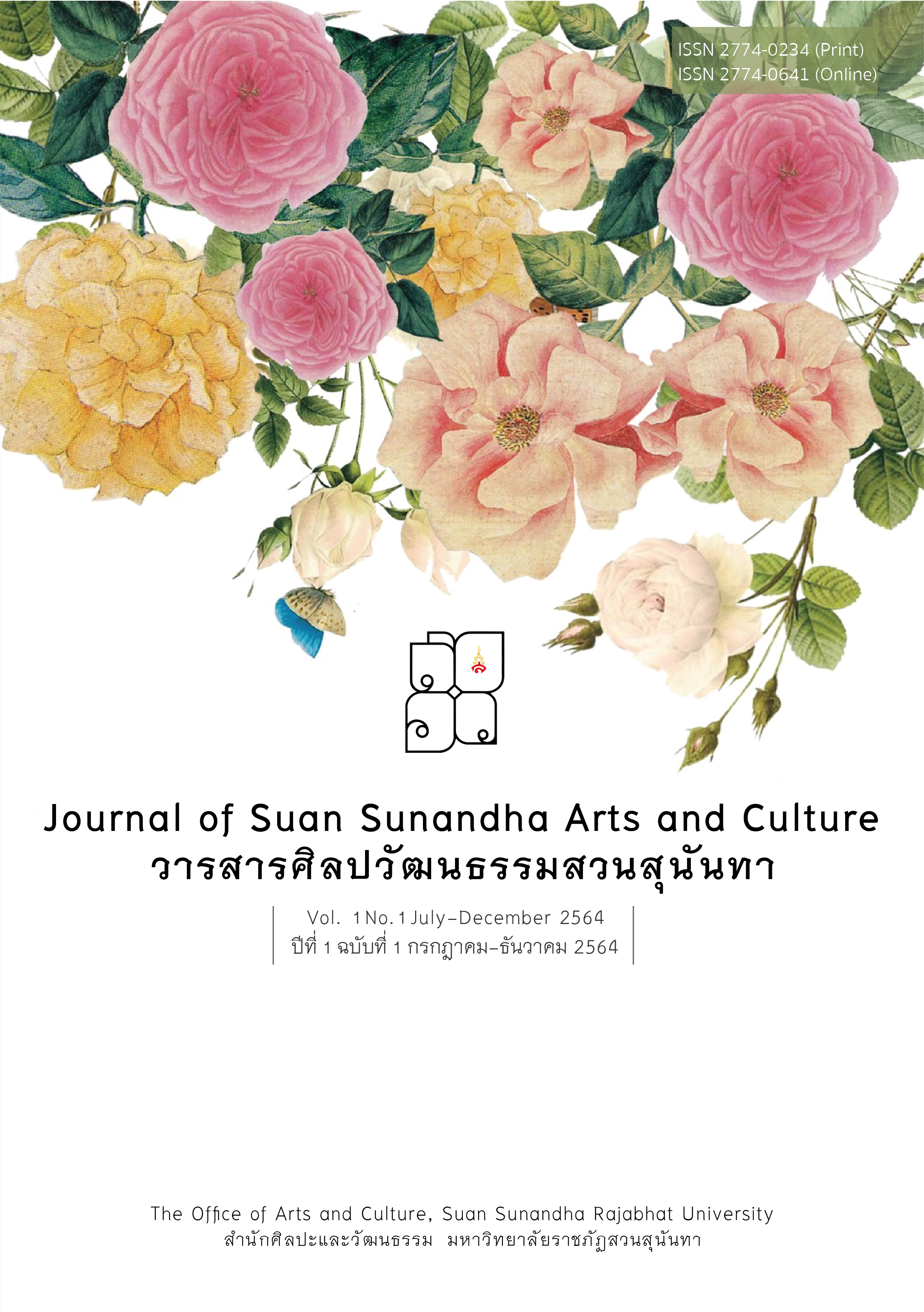THE LITTLE MERMAID BALLET 2020: BALLET TEACHING STYLES TO DEVELOP THE DANCE TECHNIQUES, MUSICAL SKILLS AND PERFORMANCE SKILLS OF THE LEARNERS
Keywords:
Teaching Styles Ballet, Dance Technique, Performance Skill, LearnerAbstract
This article describes the ballet teaching styles to develop dance technique skills, musical skills and performance skills for the Ballet Performance, The Little Mermaid 2020 of Suksiri Dance Studio. This performance is one of the academic services learning programs in 2020 of Faculty of Music and Performing Arts at Burapha University. The content demonstrates the ballet teaching styles which were adapted from Mosston’s teaching styles styles: 1) command style, 2) practical style, 3) reciprocal style, 4) self-check, 5) inclusion style, 6) guide delivery and 7) divergent style.
However, each ballet teaching style does not have a fixed formula for effective results; The instructor needs to have sufficient experience in implementing and developing a suitable teaching style for the learner group, social context, and era. Moreover, providing a stage experience for students is also a goal in dance education. The performance inspires learners to enhance knowledge and indicate their future careers to the students.
References
นภาลัย ทองปัน. “ทักษะแห่งอนาคตใหม่: การศึกษาเพื่อศตวรรษที่ 21.”วารสารเกษตรศาสตร์ (สังคม), 33 (3) กันยายน- ธันวาคม, 2556, (590-595).
ภัชภรชา แก้วพลอย. “หลักสูตรการเรียนการสอนบัลเล่ต์ในค่านิยมปัจจุบันของสังคมไทย.” วารสารดนตรีและการแสดง, 2 (1) มกราคม- มิถุนายน, 2559, (114-125).
วิจารณ์ พานิช. “วิถีสร้างการเรียนรู้เพื่อศิษย์ในศตวรรษที่ 21.” วารสารนวัตกรรมการเรียนรู้, 1 (2) กรกฎาคม-ธันวาคม, 2558,(3-14).
Howe S. “The important of dance in education.” Retrieved December 14, 2020, from https://mcsdurham.org/blog/the-importance-of-dance-in-education, 2018.
Hirata M. “Thai and foreign dancer artists prepare to perform at the Performance Art Festival 2004.” Retrieved December 14, 2020, fromhttps://www.ryt9.com/s/prg/ 152700?fbclid=IwAR1kD0xTU0YR7xkX_LySRZKr4oc58vQICVNu4RPoZ3cEFWzIgfttY1zwyU. [in Thai], 2004.
Klein N. “Plyometric Training for Dancers.” Retrieved December 14, 2020, from http://balletstrength.com/2014/11/plyometric-training-for-dancers/, 2014.
Kolb, D.A., Rubin, I.M. and Osliand, J. “Organization behavior reader.” Englewood Cliffs, NJ: Practice-Hal, 1991.
Mosston, M. & Ashworth, S. “Teaching Physical Education.” New York: Macmillan Publishing Company, 1994.
Robinson K, & Aronica L. “You, Your Child and School: Navigate Your Way to the Best Education.” New York: Viking, an imprint and division of Penguin Random House LLC, 2018.
Royal Academy of Dance. “Specification.” Retrieved December 14, 2020, from https://media.royalacademyofdance.org /media/2019/12/16143234/20191216-Specifications.pdf, 2020.
Wayback Machine. “RAD Registered Teacher Status.” Retrieved December 1, 2021, from https://web.archive.org /web/2010 1201155441/http://www.rad.org.uk/article.asp?id=30
Downloads
Published
How to Cite
Issue
Section
License
วารสารศิลปวัฒนธรรมสวนสุนันทา เป็นวารสารในรูปแบบเปิด (Open Access) ผู้ใช้ทั่วไปหรือระบบสารสนเทศของหน่วยงาน ฐานข้อมูลอัตโนมัติ ระบบห้องสมุดอัตโนมัติ สามารถเข้าถึง ดาวน์โหลด เอกสารไฟล์บทความบนเว็บไซต์วารสาร โดยไม่มีค่าใช้จ่ายแต่อย่างใด
ข้อความภายในบทความที่ตีพิมพ์ในวารสารศิลปวัฒนธรรมสวนสุนันทาทั้งหมด รวมถึงรูปภาพประกอบ ตาราง เป็นลิขสิทธิ์ของสำนักศิลปะและวัฒนธรรม มหาวิทยาลัยราชภัฏสวนสุนันทา การนำเนื้อหา ข้อความหรือข้อคิดเห็น รูปภาพ ตาราง ของบทความไปจัดพิมพ์เผยแพร่ในรูปแบบต่าง ๆ เพื่อใช้ประโยชน์ในเชิงพาณิชย์ ต้องได้รับอนุญาตจากกองบรรณาธิการวารสารอย่างเป็นลายลักษณ์อักษรอนุญาตให้สามารถนำไฟล์บทความไปใช้ประโยชน์และเผยแพร่ต่อได้ โดยอยู่ภายใต้เงื่อนไข สัญญาอนุญาตครีเอทีฟคอมมอน (Creative Commons License: CC) และ ต้องแสดงที่มาจากวารสาร – ไม่ใช้เพื่อการค้า – ห้ามแก้ไขดัดแปลง, Attribution-NonCommercial-NoDerivatives 4.0 International (CC BY-NC-ND 4.0)
ข้อความที่ปรากฏในบทความในวารสารเป็นความคิดเห็นส่วนตัวของผู้เขียนแต่ละท่านไม่เกี่ยวข้องกับสำนักศิลปะและวัฒนธรรม มหาวิทยาลัยราชภัฏสวนสุนันทา และบุคลากร คณาจารย์ท่านอื่น ๆ ในราชวิทยาลัยฯแต่อย่างใด ความรับผิดชอบองค์ประกอบทั้งหมดของบทความแต่ละเรื่องเป็นของผู้เขียนแต่ละท่าน หากมีความผิดพลาดใด ๆ ผู้เขียนแต่ละท่านจะรับผิดชอบบทความของตนเอง ตลอดจนความรับผิดชอบด้านเนื้อหาและการตรวจร่างบทความเป็นของผู้เขียน ไม่เกี่ยวข้องกับกองบรรณาธิการ



